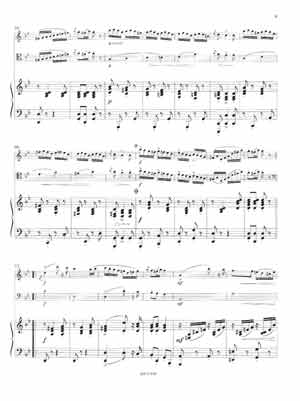
Happy Present Meet
Brahms 6 Hungarian Dances for Flute (or Violin), Cello and Piano
Brahms Six Hungarian Dances for Flute (or Violin), Cello and Piano
Trio
No.1 g minor
No.2 d monor
No.3 F major
No.4 d minor
No.5 a minor
No.6 C major
Difficulty: advanced - difficult
Performance duration: 19' 0"
Year of composition: 1868
Edition: Score and parts
Language: German • English • French
Johannes Brahms (1833-1897) composed a total of 21 Hungarian Dances for piano for 4 hands, in which he used Hungarian and gypsy melodies, but also some of his own themes "in a Hungarian style". The dances were published in two volumes, the first one in 1869 (from which the 6 dances presented here are taken), the second one in 1880.
The dances soon met with widespread popularity. A major factor contributing to this development was their instrumentation, as 4-hand piano playing was highly popular in the bourgeois households of the 19th Century. Later the dances were orchestrated by various composers and conductors, some even by Brahms himself.
The present arrangement for three different Instruments already takes a little step towards an orchestration, but keeps the essentials of the original piano part. The violin as a melody instrument is certainly an ideal choice to express Hungarian flair. Performers are invited do make their Instrument sing and sob, in particular, in the cantilenas of the 1st, 2nd and 4th dances (of course, this applies to the cello as well). Flutists have a more difficult task to perform, but to make things easier their parts have been arranged so that the flute sound can unfold its füll brilliance. For this reason, many passages are played one octave higher in the flute part than they are in the violin part. The score includes no specific notice but only shows the flute part. The fact that this is also a violin part can only be seen from the few passages, where the violin has to play double stops. To be able to make full use of the tonal range of both flute and the two string Instruments, the 4th, 5th and 6th dances had to be transposed to other keys.
This edition will allow flutists to play Brahms on their instrument; as is generally known, this is a rare occasion - except for members of symphony orchestras. Even though Brahms used the flute as an orchestral color in significant passages, e.g. in the last movement of his 1st symphony, he was written not a Single piece of flute Chamber music. The present edition tries to close this gap; after all, it provides the flute world with a piece of great music.
요하네스 브람스(1833-1897)는 총 21개의 네 손 피아노를 위한 헝가리 무곡을 작곡했는데, 여기서 그는 헝가리어와 집시 멜로디를 사용했을 뿐만 아니라 "헝가리 스타일"로 자신만의 테마도 사용했습니다. 이 춤은 두 권으로 출판되었는데, 첫 번째 책은 1869년(여기에 제시된 6개의 춤이 포함되어 있음), 두 번째 책은 1880년에 출판되었습니다.
이 춤은 곧 널리 알려지게 되었습니다. 이러한 발전에 기여한 주요 요인은 악기였습니다. 4손 피아노 연주는 19세기 부르주아 가정에서 높은 인기를 얻었습니다. 나중에는 다양한 작곡가와 지휘자가 춤을 편곡했으며 일부는 브람스가 직접 편곡하기도 했습니다.
세 가지 다른 악기에 대한 현재 편곡은 이미 오케스트레이션을 향한 약간의 단계를 밟았지만 원래 피아노 부분의 필수 요소를 유지합니다. 멜로디 악기로서의 바이올린은 확실히 헝가리의 감각을 표현하는 데 이상적인 선택입니다. 연주자들은 특히 첫 번째, 두 번째, 네 번째 춤의 칸틸레나에서 자신의 악기가 노래하고 흐느끼도록 초대됩니다(물론 이는 첼로에도 적용됩니다). 플루트 연주자는 연주하기가 더 어렵습니다. 하지만 일을 더 쉽게 하기 위해 플루트 사운드가 완전한 광채를 펼칠 수 있도록 파트를 배열했습니다. 이러한 이유로 플루트 파트에서는 바이올린 파트보다 한 옥타브 높게 연주되는 악절이 많습니다. 악보에는 특별한 공지가 없고 플루트 부분만 표시되어 있습니다. 이 부분도 바이올린 부분이라는 사실은 바이올린이 이중 정지를 연주해야 하는 몇 개의 악절에서만 알 수 있습니다. 플루트와 두 현악기의 음역을 최대한 활용하려면 4번, 5번, 6번 댄스를 다른 키로 조옮김해야 했습니다.
이 버전에서는 플루트 연주자가 자신의 악기로 브람스를 연주할 수 있습니다. 일반적으로 알려진 바와 같이 이것은 심포니 오케스트라 단원을 제외하고는 드문 경우입니다. 브람스는 중요한 구절에서 플루트를 오케스트라 색상으로 사용했지만 그의 교향곡 1번의 마지막 악장은 플루트 실내악 단 한 곡도 작곡하지 않았습니다. 본판은 이러한 격차를 해소하려고 노력하고 있습니다. 결국 그것은 플루트 세계에 훌륭한 음악을 제공합니다.
편곡자 Geller.D
작곡가 Brahms, Johannes (1833-1897)
에디터 Geller, Doris

Brahms Intermezzo Op.117 No.1 for Violin and Piano
Brahms Intermezzo Op.119 No.3 for Violin and Piano
Trios for Flute, Cello and Piano
트리오 (The Trio) Vol.1 (Flute, Violin, Piano)
3 Ragtimes for Flute(Violin), Cello and Piano
Beethoven Piano Trio in D Major, Op.70 No.1 (Ghost)
Kreisler Love`s Joy and Love`s Sorrow for Piano Trios
Chopin Piano Trio in g minor Op.8